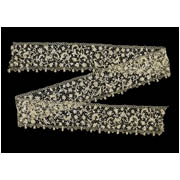Details
- Object type
lace; border
- Place Associated
Italy, Venice (possibly) (place made); France (possibly) (place made)
- Date
circa 1670-1700
- Materials
linen
- Dimensions
overall: 76 mm x 1372 mm 31 g
- Description
-
Border in cream linen point de neige or point de France buttonholed needle lace. Straight footside with double zig-zag. Headside with two alternating motifs of fleur-de-lys with a raised buttonholed ring and mirrored curls on either side of a raised buttonhole ring, both rings trimmed with picot loops. Central band with stems, foliage, flowers and scrolls in buttonhole stitch with some raised cordonnet, plain fillings, trimmed with buttonhole loops and picots, linked with hexagonally arranged buttonhole bars or brides decorated with picots.
Point de neige is a Venetian buttonholed guipure needle lace with small three-dimensional floral patterns. It is made from individual motifs, often tiered, outlined with raised work cordonnets wreaths worked in buttonhole stitch and decorated with picots. Like other guipure laces, these motifs are linked to each other with bars, also known as brides, decorated with small loops or picots. Point de neige lace is stitched over parchment draw with the design. Once completed the parchment is removed to leave the finished lace. Point de neige is similar to i>Rose point but with smaller and lighter motifs with an abundance of picot frills.
Point de France is a French buttonholed guipure lace made in France. The industry was founded in 1664 by Jean-Baptiste Colbert (1619–83), minister of finance for Louis XIV of France (1638–1715). Venetian needle lace became highly coveted throughout European during the mid-late 1600s. In an attempt to redress economic concerns about the amount of money going abroad sumptuary laws were passed to restrict use, followed by bans on imported lace. The newly-formed workshops made Venetian-style needle lace initially. This means, as in this piece, it can be hard to distinguish early examples of point de France apart from contemporary pieces of Venetian needlelace. However, in 1674 Jean Bérain the Elder (1640–1711) was appointed dessinateur de la Chambre et du Cabinet du Roi and created designs for new French styles of lace, which often included repeated verticals and a range of motifs, making them easier to identify.
Provenance: William Burrell.
- Credit Line/Donor
Gifted by Sir William and Lady Burrell to the City of Glasgow, 1944
- Collection
Burrell Collection: Lace
- ID Number
24.98
- Location
Burrell Collection


